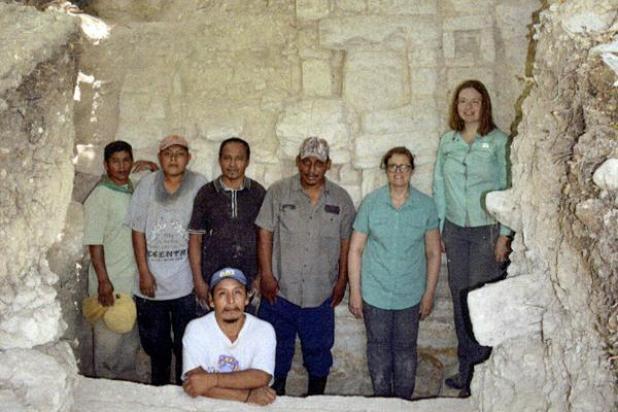
Pictured at right, Rachel Schneider is joined by a number of workers responsible for unearthing a 9-foot stone mask on the side of a temple in Buenavista, Belize. The mask’s missing eye is evident at left, and the plaster floor can be seen at the bottom of the photo.
Ancient graffiti offers glimpse into lives of Maya scribes
Graffiti isn’t always something to be excited — or even happy — about, but for archaeology student Rachel Schneider, a summer dedicated to studying it was a summer well spent.
From June 15-July 29, she was in western Belize — practically in Guatemala — on an archeology trip through the University of Texas at San Antonio. Schneider is currently pursuing her master’s degree at Brandeis University in Massachusetts. She has one semester of classes to finish, and then she’ll be writing her thesis on ancient graffiti.
Most of Schneider’s time in Belize was spent at one of two sites in the Mopan River Valley, which is studied extensively by the Mopan Valley Archaeology Project. The first, Buenavista, is well known in the archaeology community, she explained, because of a famous Maya vase found there. The second is Xunantunich, which includes the temple El Castillo.
At Buenavista, Schneider was in a supervisory role. People native to the area did the digging, while she focused on mapping and taking notes. The focus of their work was a 9-foot stone mask on the side of a temple. The mask depicts the Maya deity Chahk. The mask they excavated this summer is a twin to another on the opposite side of the temple. At first, they didn’t think there was a twin, because one eye is missing on the mask, but their persistence paid off.
Also there, the team discovered a plaster floor, which was a find on its own, but it didn’t stop there. Based on the time period, they believed that there would likely be another floor beneath it, so they returned to continue excavating, and a second floor was found. An even older third floor was thought to be farther down, but time ran out before the archaeologists could confirm whether there was. Schneider said they may continue to look for it during next year’s season.
The other site, Xunantunich, was especially interesting to Schneider, given her thesis plans. While there, her team studied a graffiti room inside El Castillo that had hundreds of examples of ancient graffiti. It appears that the room was used by scribes to practice because some areas had writing that had been crossed out with a second attempt nearby.
There’s nothing else like it, Schneider said, and archaeologists are now faced with the challenge of preserving the site, which is well over a thousand years old.
What’s interesting to Schneider is that the assumption about ancient Maya graffiti is that it was practice for scribes. That’s not something found in other cultures’ ancient graffiti.
This was Schneider’s second archaeology trip to Belize. The first was in 2016 when she was studying archaeology at Washington University in St. Louis. Her first trip was farther north and in the thick of the jungle. This site was closer to stores and restaurants, and it wasn’t unusual for her to run into other archaeologists working in the area.
Another difference is that Schneider gained some valuable and appreciated architecture experience. The site she visited in 2016, on the other hand, was more of a plaza.
Schneider intends to pursue her Ph.D. after she’s finished her master’s and hopes to return to Belize to continue studying the Maya sites.
